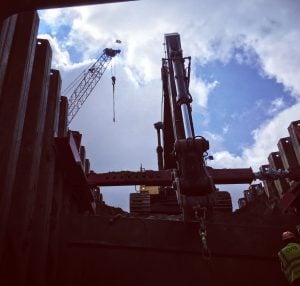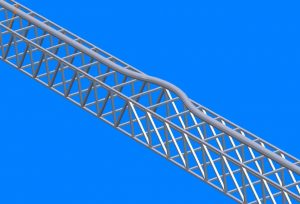With many variables to consider, there simply does not exist a “one size fits all” approach to reshoring.
To discuss reshore, we must first start with an understanding of shoring, which, according to ANSI A10.9, is “The vertical supporting members in a formwork system.” The important points here are ‘vertical’ and ‘formwork‘, which signify that we are supporting a wet, horizontal concrete slab. Easy enough? Good, then let us move on to reshore.
Reshore, also according to ANSI A10.9, is “The vertical supporting members that are used to support partially cured concrete after the removal of the formwork.” It is the system of vertical load bearing supports that are assembled AFTER the shoring is stripped or released that are intended to carry the partially cured deck or decks.
So when do you need reshoring?
Well, for starters, you do not need reshoring if you only have one slab and your shoring system is supported by the ground or other sufficiently rigid substrate. If your substrate is not sufficiently rigid, you might need reshoring to transfer the shoring loads to the rigid substrate or ground.
Reshoring is required when you are pouring a concrete slab and your shoring system must be supported by lower floors that may not have achieved full strength. It may be necessary to spread the shoring load to more than one of the partially cured slabs or floors below. This is done with reshoring.
You have heard the old saying ‘There’s more than one way to skin a cat’. Well, there is also more than one way to design reshore. Many times, it is based on the shoring designer’s preference, the slab thickness of the supported structure or the load limitations of the equipment to be used.
One approach, the Simplified Analysis, is spelled out in ACI 347.2R. There are several factors to consider but it all boils down to how much load your newly placed slabs can handle and what the load carrying capacity of your shores and reshores are.
The Simplified Analysis starts with several assumptions. First, all slabs are identical. Second, shores and reshores are aligned one-to-one from floor to floor. Third, ground level or other base support is rigid and shores are spaced closely enough to treat the shore reactions as a distributed load. Finally, shores and reshores are infinitely stiff relative to the slab.
The Simplified Analysis assumes that all slabs are identical but we know that in real life this is not always true. If you invest the time and money up front when designing the shoring layout, it will pay off in the end. That means that you must look at all of the levels or floors prior to beginning the shoring design so that you can economize the layout and reuse what you can in the reshore design. It is easiest and cheapest to maintain the same shoring/reshoring footprint from floor to floor. This pre-planning saves design time and labor hours.
The question then asked is ‘Why do you have to loosen then re-tighten shoring to re-use it as reshoring?’ In many cases, you need to loosen or drop the shoring system to allow the slab to deflect to its natural shape so that it can carry its own weight. By allowing the slab to carry itself, we then transfer only the shoring loads from above through the slab and into the reshore system preventing the accumulation of loads. Thus, the reshoring carries the load from only the shored slab.
So when do you not have to loosen and re-tighten shoring to re-use it as reshoring? When the shoring has been designed to carry the accumulated loads from the slab that it currently holds plus the supported slab or slabs above it, the current slab does not have to carry its own weight so there is no need for it to deflect. If the slab does not need to deflect, the shoring does not have to be loosened.
‘Can I always drop the deck and re-tighten the shoring to act as the reshore?’ The simple answer is no, you cannot. You must have the same leg-for-leg pattern for the shoring and reshoring and you must ensure that the partially cured slab can handle the loads imposed from the shoring system. Sometimes, the shored floor above is heavier than the current floor and the current floor slab cannot handle the loads imposed by the upper floor(s). If you do not have a leg-for-leg reshore layout or it is impractical to reshore in a leg-for-leg pattern, an engineer may be able to provide you with a reshore layout based on a structural analysis of the partially cured slab or slabs.
‘Can I always employ the “one level of shoring and two levels of reshoring” rule-of-thumb?’ No, you cannot always employ the same shoring and reshoring patterns. The number of levels of reshoring is based on the strength of the partially cured slab, the design of the structure and the capacity and frequency of the shores. Some structures are designed to allow more loads on a floor slab than others and these things need to be considered when designing a reshore pattern. The thickness of the slab plays a crucial part in the reshore design because the thicker the slab, the heavier the shoring and reshoring loads become which could require more levels of reshoring to handle these loads.
Multi-level reshore requires preplanning to maximize and economize both the shoring and reshoring layouts. Not all projects are the same and all reshore patterns are not the same. There are several factors to consider when determining how many levels of reshore are required for a given project. No matter what design or method of analysis you choose, always utilize a qualified shoring and reshoring designer to save time and money to keep your project safe and on schedule.













